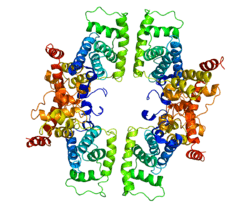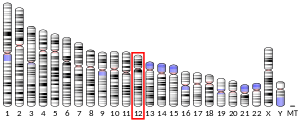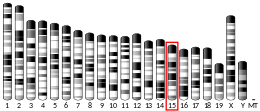Cyclin T1
Cyclin-T1 is a protein that in humans is encoded by the CCNT1 gene.[5][6]
Function
The protein encoded by this gene belongs to the highly conserved cyclin family, whose members are characterized by a dramatic periodicity in protein abundance through the cell cycle. Cyclins function as regulators of CDK kinases. Different cyclins exhibit distinct expression and degradation patterns that contribute to the temporal coordination of each mitotic event. This cyclin tightly associates with CDK9 kinase, and was found to be a major subunit of the transcription elongation factor p-TEFb. The kinase complex containing this cyclin and the elongation factor can interact with, and act as a cofactor of human immunodeficiency virus type 1 (HIV-1) Tat protein, and was shown to be both necessary and sufficient for full activation of viral transcription. This cyclin and its kinase partner were also found to be involved in the phosphorylation and regulation of the carboxy-terminal domain (CTD) of the largest RNA polymerase II subunit.[7]
Interactions
Cyclin T1 has been shown to interact with:
References
- GRCh38: Ensembl release 89: ENSG00000129315 - Ensembl, May 2017
- GRCm38: Ensembl release 89: ENSMUSG00000011960 - Ensembl, May 2017
- "Human PubMed Reference:". National Center for Biotechnology Information, U.S. National Library of Medicine.
- "Mouse PubMed Reference:". National Center for Biotechnology Information, U.S. National Library of Medicine.
- Wei P, Garber ME, Fang SM, Fischer WH, Jones KA (March 1998). "A novel CDK9-associated C-type cyclin interacts directly with HIV-1 Tat and mediates its high-affinity, loop-specific binding to TAR RNA". Cell. 92 (4): 451–62. doi:10.1016/S0092-8674(00)80939-3. PMID 9491887.
- Peng J, Zhu Y, Milton JT, Price DH (April 1998). "Identification of multiple cyclin subunits of human P-TEFb". Genes Dev. 12 (5): 755–62. doi:10.1101/gad.12.5.755. PMC 316581. PMID 9499409.
- "Entrez Gene: CCNT1 cyclin T1".
- Tian Y, Ke S, Chen M, Sheng T (November 2003). "Interactions between the aryl hydrocarbon receptor and P-TEFb. Sequential recruitment of transcription factors and differential phosphorylation of C-terminal domain of RNA polymerase II at cyp1a1 promoter". J. Biol. Chem. 278 (45): 44041–8. doi:10.1074/jbc.M306443200. PMID 12917420.
- Michels AA, Nguyen VT, Fraldi A, Labas V, Edwards M, Bonnet F, Lania L, Bensaude O (July 2003). "MAQ1 and 7SK RNA interact with CDK9/cyclin T complexes in a transcription-dependent manner". Mol. Cell. Biol. 23 (14): 4859–69. doi:10.1128/mcb.23.14.4859-4869.2003. PMC 162212. PMID 12832472.
- Hoque M, Young TM, Lee CG, Serrero G, Mathews MB, Pe'ery T (March 2003). "The growth factor granulin interacts with cyclin T1 and modulates P-TEFb-dependent transcription". Mol. Cell. Biol. 23 (5): 1688–702. doi:10.1128/mcb.23.5.1688-1702.2003. PMC 151712. PMID 12588988.
- Cabart P, Chew HK, Murphy S (July 2004). "BRCA1 cooperates with NUFIP and P-TEFb to activate transcription by RNA polymerase II". Oncogene. 23 (31): 5316–29. doi:10.1038/sj.onc.1207684. PMID 15107825.
- Young TM, Wang Q, Pe'ery T, Mathews MB (September 2003). "The human I-mfa domain-containing protein, HIC, interacts with cyclin T1 and modulates P-TEFb-dependent transcription". Mol. Cell. Biol. 23 (18): 6373–84. doi:10.1128/mcb.23.18.6373-6384.2003. PMC 193714. PMID 12944466.
- Kiernan RE, Emiliani S, Nakayama K, Castro A, Labbé JC, Lorca T, Nakayama Ki K, Benkirane M (December 2001). "Interaction between cyclin T1 and SCF(SKP2) targets CDK9 for ubiquitination and degradation by the proteasome". Mol. Cell. Biol. 21 (23): 7956–70. doi:10.1128/MCB.21.23.7956-7970.2001. PMC 99964. PMID 11689688.
- De Falco G, Bagella L, Claudio PP, De Luca A, Fu Y, Calabretta B, Sala A, Giordano A (January 2000). "Physical interaction between CDK9 and B-Myb results in suppression of B-Myb gene autoregulation". Oncogene. 19 (3): 373–9. doi:10.1038/sj.onc.1203305. PMID 10656684.
- Fu TJ, Peng J, Lee G, Price DH, Flores O (December 1999). "Cyclin K functions as a CDK9 regulatory subunit and participates in RNA polymerase II transcription". J. Biol. Chem. 274 (49): 34527–30. doi:10.1074/jbc.274.49.34527. PMID 10574912.
- Garber ME, Mayall TP, Suess EM, Meisenhelder J, Thompson NE, Jones KA (September 2000). "CDK9 autophosphorylation regulates high-affinity binding of the human immunodeficiency virus type 1 tat-P-TEFb complex to TAR RNA". Mol. Cell. Biol. 20 (18): 6958–69. doi:10.1128/mcb.20.18.6958-6969.2000. PMC 88771. PMID 10958691.
- Kanazawa S, Soucek L, Evan G, Okamoto T, Peterlin BM (August 2003). "c-Myc recruits P-TEFb for transcription, cellular proliferation and apoptosis". Oncogene. 22 (36): 5707–11. doi:10.1038/sj.onc.1206800. PMID 12944920.
- Marcello A, Ferrari A, Pellegrini V, Pegoraro G, Lusic M, Beltram F, Giacca M (May 2003). "Recruitment of human cyclin T1 to nuclear bodies through direct interaction with the PML protein". EMBO J. 22 (9): 2156–66. doi:10.1093/emboj/cdg205. PMC 156077. PMID 12727882.
Further reading
- Jeang KT (1998). "Tat, Tat-associated kinase, and transcription". J. Biomed. Sci. 5 (1): 24–7. doi:10.1007/BF02253352. PMID 9570510.
- Yankulov K, Bentley D (1998). "Transcriptional control: Tat cofactors and transcriptional elongation". Curr. Biol. 8 (13): R447-9. doi:10.1016/S0960-9822(98)70289-1. PMID 9651670.
- Romano G, Kasten M, De Falco G, Micheli P, Khalili K, Giordano A (1999). "Regulatory functions of Cdk9 and of cyclin T1 in HIV tat transactivation pathway gene expression". J. Cell. Biochem. 75 (3): 357–68. doi:10.1002/(SICI)1097-4644(19991201)75:3<357::AID-JCB1>3.0.CO;2-K. PMID 10536359.
- Cunningham AL, Li S, Juarez J, Lynch G, Alali M, Naif H (2000). "The level of HIV infection of macrophages is determined by interaction of viral and host cell genotypes". J. Leukoc. Biol. 68 (3): 311–7. PMID 10985245.
- Marcello A, Zoppé M, Giacca M (2001). "Multiple modes of transcriptional regulation by the HIV-1 Tat transactivator". IUBMB Life. 51 (3): 175–81. doi:10.1080/152165401753544241. PMID 11547919.
- Huigen MC, Kamp W, Nottet HS (2004). "Multiple effects of HIV-1 trans-activator protein on the pathogenesis of HIV-1 infection". Eur. J. Clin. Invest. 34 (1): 57–66. doi:10.1111/j.1365-2362.2004.01282.x. PMID 14984439.
- Rice AP, Herrmann CH (2003). "Regulation of TAK/P-TEFb in CD4+ T lymphocytes and macrophages". Curr. HIV Res. 1 (4): 395–404. doi:10.2174/1570162033485159. PMID 15049426.
- Minghetti L, Visentin S, Patrizio M, Franchini L, Ajmone-Cat MA, Levi G (2004). "Multiple actions of the human immunodeficiency virus type-1 Tat protein on microglial cell functions". Neurochem. Res. 29 (5): 965–78. doi:10.1023/B:NERE.0000021241.90133.89. PMID 15139295.
- Kino T, Pavlakis GN (2004). "Partner molecules of accessory protein Vpr of the human immunodeficiency virus type 1". DNA Cell Biol. 23 (4): 193–205. doi:10.1089/104454904773819789. PMID 15142377.
- Liou LY, Herrmann CH, Rice AP (2004). "HIV-1 infection and regulation of Tat function in macrophages". Int. J. Biochem. Cell Biol. 36 (9): 1767–75. doi:10.1016/j.biocel.2004.02.018. PMID 15183343.
- Pugliese A, Vidotto V, Beltramo T, Petrini S, Torre D (2005). "A review of HIV-1 Tat protein biological effects". Cell Biochem. Funct. 23 (4): 223–7. doi:10.1002/cbf.1147. PMID 15473004.
- Bannwarth S, Gatignol A (2005). "HIV-1 TAR RNA: the target of molecular interactions between the virus and its host". Curr. HIV Res. 3 (1): 61–71. doi:10.2174/1570162052772924. PMID 15638724.
- Gibellini D, Vitone F, Schiavone P, Re MC (2005). "HIV-1 tat protein and cell proliferation and survival: a brief review". New Microbiol. 28 (2): 95–109. PMID 16035254.
- Peruzzi F (2006). "The multiple functions of HIV-1 Tat: proliferation versus apoptosis" (PDF). Front. Biosci. 11: 708–717. doi:10.2741/1829. PMID 16146763.





